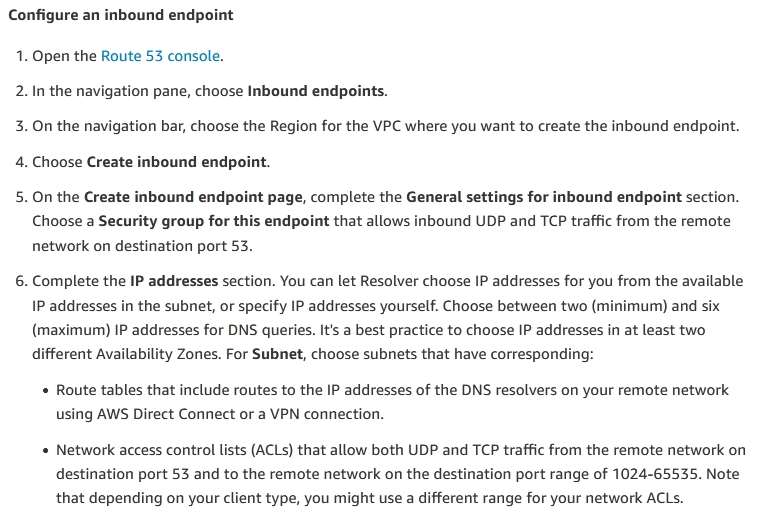A company is trying to connect two applications. One application runs in an on-premises data center that has a hostname of host1.onprem.private. The other application runs on an Amazon EC2 instance that has a hostname of host1.awscloud.private. An AWS Site-to-Site VPN connection is in place between the on- premises network and AWS.
The application that runs in the data center tries to connect to the application that runs on the EC2 instance, but DNS resolution fails. A SysOps administrator must implement DNS resolution between on-premises and AWS resources.
Which solution allows the on-premises application to resolve the EC2 instance hostname?
A. Set up an Amazon Route 53 inbound resolver endpoint with a forwarding rule for the onprem.private hosted zone. Associate the resolver with the VPC of the EC2 instance. Configure the on-premises DNS resolver to forward onprem.private DNS queries to the inbound resolver endpoint.
B. Set up an Amazon Route 53 inbound resolver endpoint. Associate the resolver with the VPC of the EC2 instance. Configure the on-premises DNS resolver to forward awscloud.private DNS queries to the inbound resolver endpoint.
C. Set up an Amazon Route 53 outbound resolver endpoint with a forwarding rule for the onprem.private hosted zone. Associate the resolver with the AWS Region of the EC2 instance. Configure the on- premises DNS resolver to forward onprem.private DNS queries to the outbound resolver endpoint.
D. Set up an Amazon Route 53 outbound resolver endpoint. Associate the resolver with the AWS Region of the EC2 instance. Configure the on-premises DNS resolver to forward awscloud.private DNS queries to the outbound resolver endpoint.
The application that runs in the data center tries to connect to the application that runs on the EC2 instance, but DNS resolution fails. A SysOps administrator must implement DNS resolution between on-premises and AWS resources.
Which solution allows the on-premises application to resolve the EC2 instance hostname?
A. Set up an Amazon Route 53 inbound resolver endpoint with a forwarding rule for the onprem.private hosted zone. Associate the resolver with the VPC of the EC2 instance. Configure the on-premises DNS resolver to forward onprem.private DNS queries to the inbound resolver endpoint.
B. Set up an Amazon Route 53 inbound resolver endpoint. Associate the resolver with the VPC of the EC2 instance. Configure the on-premises DNS resolver to forward awscloud.private DNS queries to the inbound resolver endpoint.
C. Set up an Amazon Route 53 outbound resolver endpoint with a forwarding rule for the onprem.private hosted zone. Associate the resolver with the AWS Region of the EC2 instance. Configure the on- premises DNS resolver to forward onprem.private DNS queries to the outbound resolver endpoint.
D. Set up an Amazon Route 53 outbound resolver endpoint. Associate the resolver with the AWS Region of the EC2 instance. Configure the on-premises DNS resolver to forward awscloud.private DNS queries to the outbound resolver endpoint.
